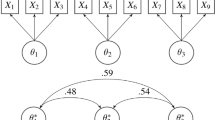Abstract
Few reports about methods of evaluating quality of life (QoL) among the thousands published since medical interest in the subject slowly began nearly 40 years ago are based upon theory. This paper, prepared in response to a request to furnish an exception (Meadows KA. Introduction to an Advanced Seminar: Assessing Health-Related Quality of Life. What can the Cognitive Sciences Contribute? Hull University, October 9, 2000) describes the origins of the Schedule for the Evaluation of Individual Quality of Life (SEIQoL). This derives its cognitive aspects from theoretical studies of perception by Egon Brunswik, their extension to Social Judgment Theory (SJT) by Kenneth Hammond and the application of these ideas to QoL by the present authors and their colleagues.
Similar content being viewed by others
References
Joyce CRB, O'Boyle CA, McGee HM. Individual Quality of Life: Approaches to Conceptualisation and Assessment. Amsterdam: Harwood, 1999.
Bullinger M. Cognitive theories and individual quality of life assessment (in ref. [2]).
Joyce CRB, Caple G, Mason M, Reynolds E, Mathews JA. Quantitative study of doctor-patient communication. Quart J Med 1969; 38: 183–94.
Balint M, Hunt J, Joyce CRB, Marinker M, Woodcock J. Treatment or Diagnosis: A Study of Repeat Prescriptions in General Practice. London: Tavistock, 1970.
Hammond KR, Joyce CRB (eds). Psychoactive Drugs and Social Judgment. New York: Wiley, 1975.
Hammond KR, Stewart TR (eds). Egon Brunswik. Oxford: University Press, 2001 (see also Hammond KR. Human Judgment and Social Policy: Irreducible Uncer-tainty, Inevitable Error, Unavoidable Injustice. New York: Oxford University Press, 1996).
Brunswik E. Wahrnehmung und Gegenstandswelt. Grundlegung einer Psychologie vom Gegenstand her. Habilitationsschrift. Leipzig and Vienna: F Deuticke. See also: Fischer KR, Stadler F (eds), Wahrnehmung und Gegenstandswelt. 1934; Zum Lebenswerk von Egon Brunswik. Vienna: Springer, 1996.
Johnson D. New York Review of Books. Oct. 12, 1989; pp. 25–27.
Larkin P. Required Writing. London: Faber and Faber, 1974.
Bateson MC. Our Own Metaphor. New York: Knopf, 1972 (q by Aldridge D. Making and taking health care decisions. J Roy Soc Med 1990; 83: 720-723).
Greer S. Can psychological therapy improve the quality of life of patients with cancer? Br J Cancer 1989; 59: 149–15.
James W. The Principles of Psychology. New York: Dover, 1950.
Joyce CRB. Quality of Life: the state of the art in clinical assessment. In: Walker SW, Rosser RM (eds), QoL Assessment and Application, Lancaster: MTP Press, 1988.
Strunk W, White EB. The Elements of Style. 3rd ed. New York: Macmillan, 1979.
Steiner G. Real Presences. Chicago: University of Chicago Press, 1989.
Brunswik E. Organismic achievement and environmental probability. Psychological Review 1943; 50: 255–272.
Nagel E. The Structure of Science: Problems in the Logic of Scientific Explanation. London: Routledge and Kegan Paul, 1961.
Hammond KR, McClelland GH, Mumpower J. Human Judgment and Decision Making: Theories, Methods, and Procedures, 1990. New York: Praeger, 1980.
Brunswik E. Perception and the Representative Design of Psychological Experiments 2nd ed. Berkeley: University of California Press, 1956.
Lewin K. A Dynamic Theory of Personality. New York: McGraw-Hill, 1935.
See the web site of the Brunswik Society: http://www. brunswik.org.
Arkes HR, Hammond KR. Judgment and Decision Making: An interdisciplinary reader. Cambridge: Cambridge University Press, 1986.
Harding REM. An anatomy of Inspiration. Appendix by Robert Nichols: The Birth of a Poem. 2nd ed. New York: Barnes and Noble, 1967.
Hammond KR. Human Judgment and Social Policy: Irreducible Uncertainty, Inevitable Error, Unavoidable Injustice. New York: Oxford University Press, 1996.
O'Boyle C, McGee HM, Hickey A, et al. The Schedule for the Evaluation of Individual Quality of Life (SEIQoL): Administration Manual. Dublin: Department of Psychology Royal College of Surgeons in Ireland, 1993.
Browne JP, O'Boyle CA, McGee HM, McDonald NJ, Joyce CRB. Development of a direct weighting procedure for quality of life domains. Qual Life Res 1997; 6: 301–309.
Cooksey RW. Judgment Analysis: Theory, Methods and Applications. San Diego: Academic Press, 1996.
Basho Matsuo. The Narrow Road to the Deep North. London: Penguin, 1966.
Joyce CRB. Is God a Placebo? In: J Schmidt (ed), Proceedings of the 3rd Einsiedeln Symposium, 1997. Res Comp Med 1999; 5(S1): 102–111
Author information
Authors and Affiliations
Rights and permissions
About this article
Cite this article
Joyce, C., Hickey, A., McGee, H. et al. A theory-based method for the evaluation of individual quality of life: The SEIQoL. Qual Life Res 12, 275–280 (2003). https://doi.org/10.1023/A:1023273117040
Issue Date:
DOI: https://doi.org/10.1023/A:1023273117040



